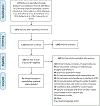Social media use and self-injurious thoughts and behaviors: A systematic review and meta-analysis
- PMID: 34034038
- PMCID: PMC8243901
- DOI: 10.1016/j.cpr.2021.102038
Social media use and self-injurious thoughts and behaviors: A systematic review and meta-analysis
Abstract
Despite considerable public and scholarly debate about the role of social media in self-injurious thoughts and behaviors (SITBs), no comprehensive, quantitative synthesis of this literature has previously been undertaken. The current systematic review and meta-analysis examines associations between social media use and SITBs, including suicidal ideation, suicide plans, suicide attempts, and nonsuicidal self-injury (NSSI). A range of social media behaviors and experiences were identified, including cybervictimization and perpetration, exposure to and generation of SITB-related content, problematic use, sexting, social media importance, and frequency of use. A systematic search of PsycINFO, Medline, CINAHL, and the references of prior reviews yielded 61 eligible studies. Results largely suggested medium effect sizes for associations between specific social media constructs (cybervictimization, SITB-related social media use, problematic social media use) and SITBs. There was no association between frequency of social media use and SITBs; however, studies on this topic were limited. The majority of studies identified focused on cybervictimization, and results suggested positive associations with all SITBs, with the association between cybervictimization and suicidal ideation stronger for adolescents than adults. Overall, findings highlight the utility of examining specific social media behaviors and experiences, and point to the need for more research in this area.
Keywords: Nonsuicidal self-injury; Self-injurious behaviors; Social media; Suicidal ideation; Suicide attempt; Suicide plans.
Copyright © 2021 Elsevier Ltd. All rights reserved.
Conflict of interest statement
Statement 3: Conflict of Interest
The authors declare that they have no conflicts of interest
Figures




Similar articles
-
Prevalence and Correlates of Suicide and Nonsuicidal Self-injury in Children: A Systematic Review and Meta-analysis.JAMA Psychiatry. 2022 Jul 1;79(7):718-726. doi: 10.1001/jamapsychiatry.2022.1256. JAMA Psychiatry. 2022. PMID: 35612875 Free PMC article.
-
Examining the Course of Suicidal and Nonsuicidal Self-Injurious Thoughts and Behaviors in Outpatient and Inpatient Adolescents.J Abnorm Child Psychol. 2017 Jul;45(5):971-983. doi: 10.1007/s10802-016-0214-0. J Abnorm Child Psychol. 2017. PMID: 27761783 Free PMC article.
-
Prevalence and correlates of adolescent self-injurious thoughts and behaviors: A population-based study in Burkina Faso.Int J Soc Psychiatry. 2023 Nov;69(7):1626-1635. doi: 10.1177/00207640231175778. Epub 2023 Jun 16. Int J Soc Psychiatry. 2023. PMID: 37329143 Free PMC article.
-
Longitudinal association between self-injurious thoughts and behaviors and suicidal behavior in adolescents and young adults: A systematic review with meta-analysis.J Affect Disord. 2017 Jun;215:37-48. doi: 10.1016/j.jad.2017.03.035. Epub 2017 Mar 12. J Affect Disord. 2017. PMID: 28315579 Review.
-
Self-injurious thoughts and behaviors as risk factors for future suicide ideation, attempts, and death: a meta-analysis of longitudinal studies.Psychol Med. 2016 Jan;46(2):225-36. doi: 10.1017/S0033291715001804. Epub 2015 Sep 15. Psychol Med. 2016. PMID: 26370729 Free PMC article. Review.
Cited by
-
Commercial determinants of mental ill health: An umbrella review.PLOS Glob Public Health. 2024 Aug 28;4(8):e0003605. doi: 10.1371/journal.pgph.0003605. eCollection 2024. PLOS Glob Public Health. 2024. PMID: 39196874 Free PMC article.
-
Self-mutilation: a systematic review.Forensic Sci Med Pathol. 2024 Apr 13. doi: 10.1007/s12024-024-00809-4. Online ahead of print. Forensic Sci Med Pathol. 2024. PMID: 38613622 Review.
-
Problematic social media use and psychological symptoms in adolescents.Soc Psychiatry Psychiatr Epidemiol. 2024 Dec;59(12):2271-2278. doi: 10.1007/s00127-024-02657-7. Epub 2024 Apr 7. Soc Psychiatry Psychiatr Epidemiol. 2024. PMID: 38584201 Free PMC article.
-
Social and circadian rhythm dysregulation and suicide: A systematic review and meta-analysis.Neurosci Biobehav Rev. 2024 Mar;158:105560. doi: 10.1016/j.neubiorev.2024.105560. Epub 2024 Jan 23. Neurosci Biobehav Rev. 2024. PMID: 38272337
-
Social Media and Youth Mental Health.Curr Psychiatry Rep. 2024 Jan;26(1):1-8. doi: 10.1007/s11920-023-01478-w. Epub 2023 Dec 16. Curr Psychiatry Rep. 2024. PMID: 38103128 Review.
References
-
- Anderson M, & Jiang J (2018a). Teens, Social Media, & Technology. www.pewresearch.org.
-
- Anderson M, & Jiang J (2018b). Teens’ Social Media Habits and Experiences.
-
- Arendt F, Scherr S, & Romer D (2019). Effects of exposure to self-harm on social media: Evidence from a two-wave panel study among young adults. New Media and Society, 21(11–12), 2422–2442. 10.1177/1461444819850106 - DOI
-
- Baker DA, & Algorta GP (2016). The relationship between online social networking and depression: a systematic review of quantitative studies. Cyberpsychology, Behavior, and Social Networking, 19(11), 638–648. - PubMed
-
- Beckman L, Hagquist C, & Hellström L (2013). Discrepant gender patterns for cyberbullyiyng and traditional bullying - An analysis of Swedish adolescent data. Computers in Human Behavior, 29(5), 1896–1903. 10.1016/j.chb.2013.03.010 - DOI
Publication types
MeSH terms
Grants and funding
LinkOut - more resources
Full Text Sources
Other Literature Sources
Medical

